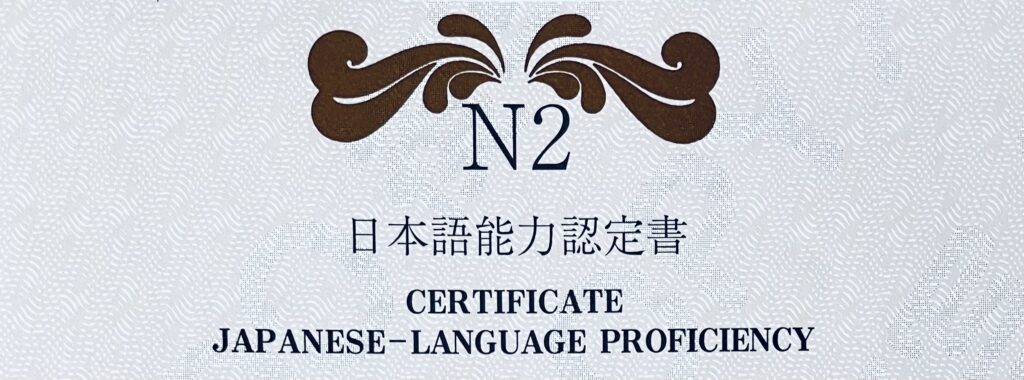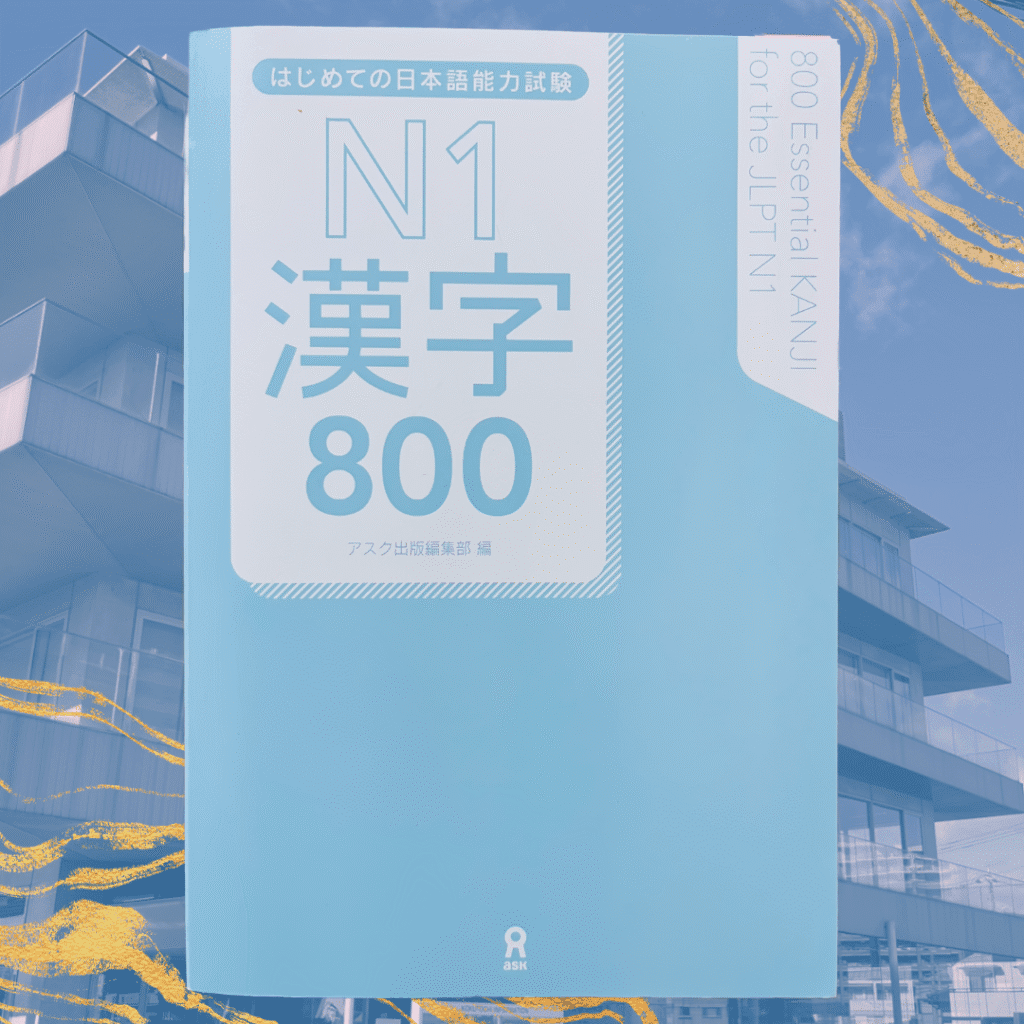In December 2024, I took the JLPT N1 test. And failed.
But it taught me an important lesson: how and what to study.
Though I passed N2 a few years ago, I wanted to benchmark my Japanese by taking the next level. Now I’m determined to pass.
If you’re taking the JLPT this year, here’s how to sign up and prepare for the test.
What is the JLPT?

JLPT stands for Japanese Language Proficiency Test (日本語能力試験). It’s a test that measures your ability to read, comprehend, and listen to Japanese. There are currently no speaking or writing components.
It’s held twice a year in Japan: the first Sunday of July, and the first Sunday of December. In other countries, it may only be held once a year.
The JLPT test levels are listed from N5-N1. N5 is the most basic level, while N1 is the most advanced.
For most applicants, taking JLPT levels N3-N1 is the most common. It’s also the most cost-effective. Applying to take the JLPT costs about ¥7500 (~$50). So only sign up if you’re confident in your Japanese level.
How to Register for the JLPT in the US
In the US, the AATJ, or American Association of Teachers of Japanese, is the administrator of the JLPT.
First, identify your closest testing area. Some states only have a couple of test sites, while some don’t have any.
Then apply using the US JLPT portal administered by the AATJ:
Then you can bring the same items as listed below. Follow the rules for taking the test in your area. For example, turn off your phone completely, and make sure your watch isn’t a smartwatch.
Taking the JLPT in San Francisco

In 2018 I took the JLPT N2, and that time, I passed.
This was just 3 months after returning from my study-abroad experience at Waseda. Simply put, I studied my ass off, and it paid off.
Preceding the test, I would listen to the NHK Radio News podcast in Japanese every morning while getting ready and commuting to SF State.
Then I’d practice kanji online and try reading the Hobonikkan Itoi Shinbun blog. I also took Japanese classes as I was finishing my degree.
I felt my nerves on alert as I rushed to the test site. Though it was at my own university, SFSU, I was running late.
The test being held at my home university gave me a false sense of security that almost made me late. Not to mention I was relying on public transit to get there.
Luckily I made it in time, but I was frazzled. If you can, go to your testing site early – especially if you take buses or trains.
When I arrived, I could feel the “standardized test” vibe in the air– lots of proctors amongst a serious atmosphere.
There were test-takers of all ages, from young grade-schoolers to adults.
The test is conducted the same as in Japan, except they didn’t check my identity as often. The content is in Japanese, and it’s a serious test. One person’s phone going off can disqualify everyone in the room.
Regarding the test content, I remember feeling sweaty and rushed, but not out of my comfort zone. I wasn’t sure if I would pass, but it wasn’t a disaster.
Our results came out months later, and I even received a physical certificate!
How to Register for the JLPT in Japan
Registering to take the test in Japan is straightforward, but takes time. The full breakdown is on the official JLPT Japan website.
The test is held twice a year, in summer and winter. Registration opens about 3 months before the test.
Summer registration opens around March. Winter registration opens around September.
1. Register a MyJLPT account
Sign up on the MyJLPT website. Keep a record of your login ID. You’ll need it to login.
This website is where you’ll apply and receive information about the test.
2. Submit an Application
- Go to the Examination Application page on MyJLPT
- Select ‘Individual Application’
- Fill in your information
- Your address needs to match your residence card. You should also have a nameplate on your apartment or dorm. It doesn’t need to be fancy.
- If the courier can’t confirm your address, they may not deliver your test voucher.
- Upload a photo and select your region
- Pay the fee (¥7500 in 2025)
3. Receive Your Test Voucher
This is your ticket to take the test. It will be mailed to you. Keep it somewhere safe. Preferably in a clear file.
4. Prepare Materials
You should bring these items:
- Test Voucher
- Residence card
- Pencil (HB)
- Mechanical Pencil
- Eraser (without the eraser sleeve)
- Watch (on silent mode, no smart watches allowed.)
- Water bottle
- Food (keep in your bag)
5. Take the Test
Don’t be late. Proctors will check your identity every time a new section starts. There is a break between the reading and listening portions. And if you get hungry, bring a snack for the break.
You may bring your phone but turn it off completely while taking the test.
Tip: The official website says not to take a car. I think this is targeted toward busy city areas. Use your own common-sense and arrive to the test center the best way for you. As long as you don’t cause a disturbance you should be fine.
Taking the JLPT in Utsunomiya

When I took the JLPT in Japan, almost 7 years after the first, the atmosphere felt different. I wasn’t nervous, but I wasn’t confident in my ability to pass.
This time, the test takers were all adults living in Japan. Some were students, though many were workers.
Since many people take the test, the test sites are different based on your area and level.
I drove to the venue in Utsunomiya. There was some parking, and I bought lunch at a conbini to eat between test sections.
The testing rooms opened, and we filed in. More of a lecture hall this time, our seats were pre-determined just like in the US. We put our phones in plastic bags provided by the proctors, and set up our pencils, erasers, and whatnot. It was surprisingly similar to the US test.
However, this time the proctors ran up and down the aisles to check everyone’s verification card and photo. And everything is conducted in Japanese of course.
I was out of my depth at this level of Japanese, but I tried my best. Listening was a no-brainer, but my scores for kanji and grammar were miserable. I struggled during the long readings.
My studying was lacking, and while my cultural understanding of Japan was improving at work, I still wasn’t prepared for the test.
I realized that I needed to start earnestly reading in Japanese. Not just snippets of newspaper articles or the test-prep material, but real writing. Novels, magazines, internet articles.
I plan to take the JLPT again this year. Hopefully, I’ll pass. I’m practicing by actively seeking out Japanese media like YouTubers, continuing to listen to Japanese music, and reading novellas aimed at the junior high school level.
JLPT Levels
The JLPT levels are as follows:
N5
Rudimentary
Listening: Can understand daily life and classroom Japanese when spoken slowly.
Reading: Can read hiragana, katakana, and some basic kanji for daily expressions.
N4
Basic
Listening: Can understand conversations in daily life and familiar topics when spoken slowly.
Reading: Can read hiragana, katakana, and some kanji on familiar topics.
N3
Intermediate
Listening: Can understand everyday conversations at almost natural speed, on a wider range of topics.
Reading: Can read a wider range of specific, everyday topics, grasp newspaper headlines, and understand more variety of topics.
N2
Advanced (Conversational level)
Listening: Can understand presentations, announcements and other conversations and grasp their meaning and speakers’ relationships at near natural speed.
Reading: Can understand materials on various topics like magazines or articles. Can follow the contents of general topics and understand the writer’s intent.
N1
Fluent (Business level)
Listening: Can fully understand the contents of a variety of situations from lectures to news reports. Can comprehensively understand the relationships and intent of speakers, and logical flow.
Reading: Can fully grasp the meaning of a variety of topics and materials, from newspapers to critiques. Can follow the writer’s intent and the written narratives completely.
Studying for the JLPT

There are many ways to study for the JLPT. Of course, you need to target all areas of study, from reading and writing to listening.
First, decide what level you’ll take. Then, research what grammar, kanji, etc., you need to know on the JLPT website. You can also try some example questions from the previous tests.
I began studying Japanese in high school, where I learned the basics. I continued in college to review those basics. But once I began studying Japanese abroad at Waseda University, I had to kick it up a notch. That meant studying hard, reading a lot of text, learning more kanji, and speaking with my classmates often.
If you can, I highly recommend studying abroad in Japan to get full immersion in Japanese. But even if you can’t, watching Japanese media, listening to music, and trying to read as much Japanese as possible will all help.
And while general Japanese studies will help you pass, I recommend using specific JLPT study materials like the Nihongo Sō-Matome (日本語総合まとめ) series. (Not sponsored, just what I use).
Textbooks geared directly toward passing the JLPT will come with examples and practice tests that help you become familiar with the test format.
Quick Study Tips
- Use textbooks and materials aimed specifically at passing the JLPT
- Review kanji every day with flashcards
- Listen to NHK radio news every morning for at least 15 minutes
- Watch YouTubers in Japanese with subtitles
- Try searching for something you would watch anyway, just in Japanese for best results.
- Listen to Japanese music and memorize the lyrics
- Read short passages using apps like Todaii or the Almost Daily Itoi Shinbun blog
Basic Japanese (N5-N4)
Great starter textbooks for this level are Genki 1 and Minna no Nihongo. If you’re low on cash, you can probably find online options to study from.
In high school, we used Adventures in Japanese, and they have some good online resources.
However, if you’re doing self-study or are college-age or up, I would go with the other options since they’re mainly geared towards adults.
No matter which series you try, stick with it, and for the love of all that is good, do the workbook exercises! Yes, most of these books will come with separate workbooks. These are really important to drive home what you learned.
Intermediate Japanese (N3)
From here, you can continue the Genki and Minna no Nihongo Series.
Then you can use books like Tobira and the Chukyū wo Manabō 中級を学ぼう series to increase your level.
I also particularly recommend the Kanji: Look and Learn textbook and accompanying workbook.
Once you finish those, move onto Intermediate Kanji 1 and 2 and the workbooks. Use resources like Wanikani, Anki or other flashcard apps to review and keep them fresh in your head.
Try reading news using apps like Todaii and keep your skills up with relevant stories.
And don’t just read or listen, try writing in Japanese too. Write short stories, translate your favorite song lyrics, or write an essay or speech- then present it!
Advanced Japanese (N2-N1)
You should know the basics by heart, most written grammar points, keigo, and lots and lots of kanji.
At this level, I used Authentic Japanese: Progressing from Intermediate to Advanced (生きた素材で学ぶ 新・中級から上級への日本). It contains lots of grammar and reading comprehension passages.
You can also continue the Intermediate Kanji books for N2. Once you finish them, you can use the N1 prep books like Sō-Matome and Ippatsu Gōkaku
Try reading middle-grade novels, newspaper articles, and watching/listening to programs like NHK Radio news often. Preferably, read novels and articles on similar topics to refresh your knowledge.
If you don’t have access to study abroad opportunities or immersion in Japan, consider getting a Japanese tutor to speak with and hone your other skills.
At a certain point, achieving N1 involves more than book study. As much as you could become fluent by studying, you still have to interact with Japanese literature, media, and culture to achieve fluency. And it doesn’t stop there.
The jump from N2 to N1 has been wider so far than any of the other levels. Book smarts can get you as far as N2. But to achieve N1 you have to be able to function as an adult in Japanese. I would say this is equivalent to a Japanese 9th grader (the last year of required education in Japan).
At the end of the day, passing N1 isn’t the finish line. It’s just the beginning of your fluency in Japanese. So keep studying and just do your best!
How I study for the JLPT
I use the Nihongo Sō-Matome series for kanji, while I’ve used books like those above for grammar and reading.
I enjoy listening to music and studying the lyrics of my favorite songs, watching Japanese YouTubers, and playing Animal Crossing in Japanese to “passively” study.
Many websites like JLPTtest4you and JLPTsensei also have free resources for learning online or supplementing your current studies.
I also watched this video by KemushiChan to get an idea of how to study, and what the test was like when I took the N2.
If you plan to take the JLPT this year, what level will you attempt?




